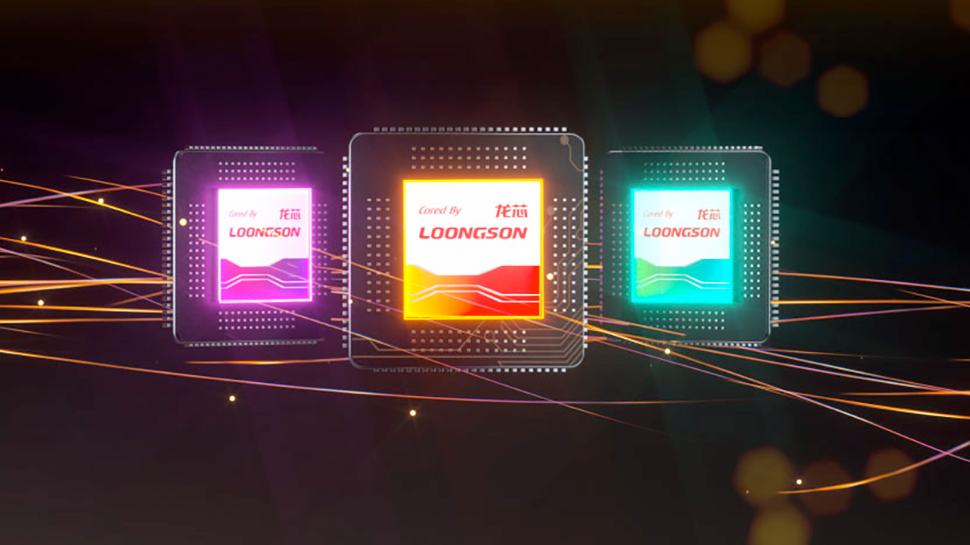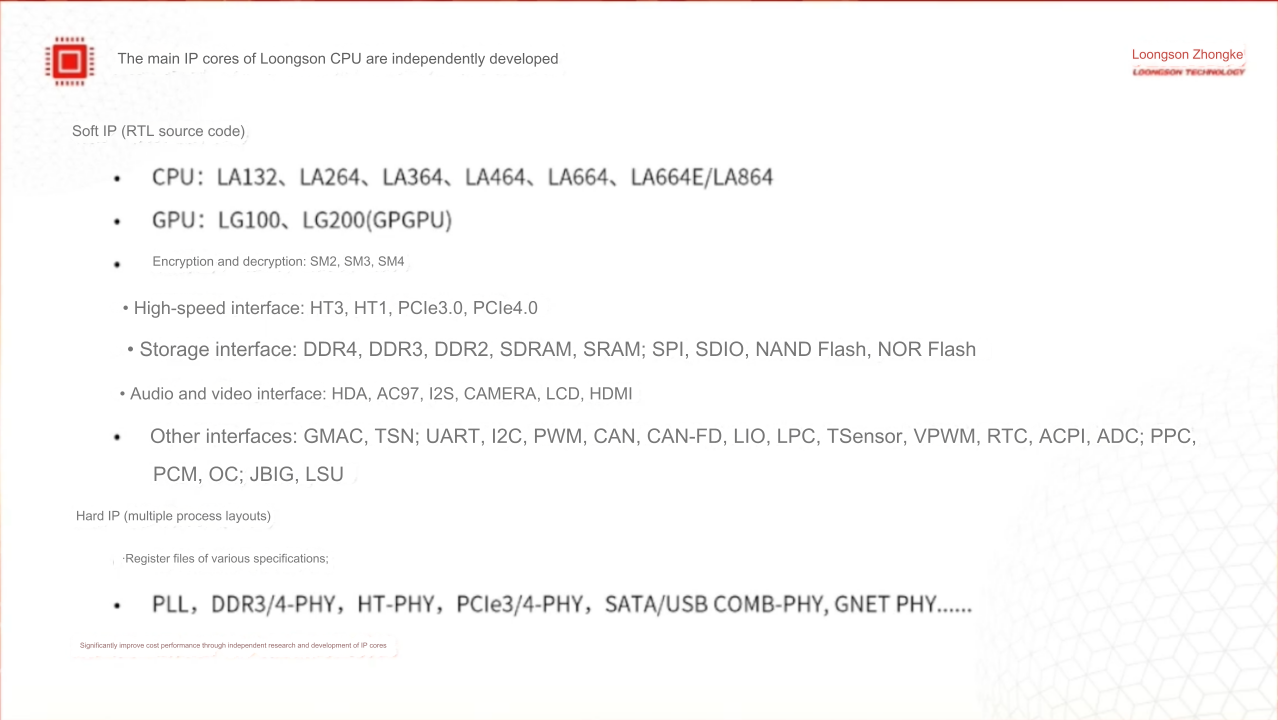Homegrown Chinese CPUs are catching up to AMD and Intel — Loongson 3B6600 and 3B7000 allegedly match Intel 10th Gen CPU performance
Some of its iGPU features are likely not as strong!

Zhang Ge, the CEO of Loongson, revealed the company's next-generation octa-core 3B6600 and 3B7000 CPUs for the Chinese market. Both these CPUs are made for the mainstream market, emphasizing single-core performance rather than multi-core.
Loongson admitted that while the 3B6600 and 3B7000 are behind the competition in multi-core performance, the company has significantly closed the gap in single-core performance. Loongson claims a 20X uplift compared to the company's previous processors. We've already seen the 3A6000 in action, exhibiting a similar IPC level close to AMD's Zen 4 and Intel's Raptor Lake.
The 3B6600 features eight LA854 CPU cores and an LG200 on-chip graphics core clocked at 3.0 GHz. The 3B7000 CPU also has eight LA864 cores clocked with 3.5 GHz, but it doesn't mention its iGPU.
Based on the information provided by the company, the 3B7000 supports PCIe 4.0, SATA III, USB 3.0, GMAC, and HDMI output. It also has integrated INT8 Tensor accelerators for LLM workloads. It also supports OpenCL 3.0 computing and OpenGL 4.0 graphics acceleration. Its on-chip graphics can get up to 256 GFLOPs of computing performance, and with a discrete graphics solution, it can achieve up to 1TFlops. There's no other information left, but the mini PC with the 3A6000 CPU only supported 4K at 30Hz. Hence, there's a possibility that this iGPU will lack some functions and support. Interestingly, it seems to support multiple RAM interfaces such as SRAM, SDRAM, DDR2, and DDR3, followed by DDR4.




There is conflicting information presented in its slide: one shows these chips to be 'next-generation notebook chips,' while the roadmap shows both to be desktop processors. Time will tell. While these chips are made for the domestic market, one can't help but speculate about the possibility of seeing them retail in a country affected by the sanctions imposed by the US and the EU.
Loongson is ambitious to compete against x86 and ARM offerings with its 'Dragon' architecture. With China already blocking the use of Intel and AMD CPUs for its official government use and schools ordering domestically-made chips, Loongson will have a much larger share of the domestic market in multiple sectors. However, its success remains to be seen in its mainstream market.
The IPC comparison with the Loongson CPUs reminds me of Pat Gelsinger's comment about Chinese-made CPUs being decades behind. But with companies like Loongson making such progress, one wonders if the domestic chipmakers can close the gap sooner than ten years.
Get Tom's Hardware's best news and in-depth reviews, straight to your inbox.
Making CPUs is easier said than done, but China has consistently imported chipmaking tools by hook or crook. The sanctions would be seen as a blessing in disguise for the Chinese chip production business in terms of market share and innovation. That said, Russia still has to achieve the same level of success with its chipmaking ventures.

Roshan Ashraf Shaikh has been in the Indian PC hardware community since the early 2000s and has been building PCs, contributing to many Indian tech forums, & blogs. He operated Hardware BBQ for 11 years and wrote news for eTeknix & TweakTown before joining Tom's Hardware team. Besides tech, he is interested in fighting games, movies, anime, and mechanical watches.
-
thisisaname Claiming a 20X improvement, if Intel, AMD or Nvidia claimed a similar improvement I would still say I'm waiting for some independent benchmark before I believed it.Reply -
ivan_vy "The IPC comparison with the Loongson CPUs reminds me of Pat Gelsinger's comment about Chinese-made CPUs being decades behind. But with companies like Loongson making such progress, one wonders if the domestic chipmakers can close the gap sooner than ten years."Reply
they will be fine, Steam Survey HW shows 55% of CPU are 4 and 6 cores,
https://store.steampowered.com/hwsurvey/Steam-Hardware-Software-Survey-Welcome-to-Steamthese octa core will be enough for all the office and government clients that have no other options, not all customers need cutting edge silicon. -
Pierce2623 The headline is a bit ridiculous when zen1 on 14nm still smokes this chip. China is also at the absolute limits of the process node technology that they have currently available to them. This “advanced 7nm” node can’t keep up with TSMC 12nm even in the mobile segment that this node was optimized for.Reply -
usertests Reply
Maybe they'll never truly catch up until all progress halts, but these alternatives are clearly reaching levels of performance that would be good enough for many personal computing use cases. Around quad-core Skylake or Intel N100 is the threshold IMO.Pierce2623 said:The headline is a bit ridiculous when zen1 on 14nm still smokes this chip. China is also at the absolute limits of the process node technology that they have currently available to them. This “advanced 7nm” node can’t keep up with TSMC 12nm even in the mobile segment that this node was optimized for.
I think the biggest downside would be if the chips were inordinately expensive compared to the comparable obsolete or low-end products from the West, with the process node using multiple patterning and delivering bad yields. -
Pierce2623 Reply
Fair enough. From what I’m seeing, they should be fairly close to n100 level now if they’re floating between Skylake and Kaby Lake performances. The last n100 scores I’ve seen were pretty close to 6500/7500 non-k performance.usertests said:Maybe they'll never truly catch up until all progress halts, but these alternatives are clearly reaching levels of performance that would be good enough for many personal computing use cases. Around quad-core Skylake or Intel N100 is the threshold IMO.
I think the biggest downside would be if the chips were inordinately expensive compared to the comparable obsolete or low-end products from the West, with the process node using multiple patterning and delivering bad yields. -
killingfield Reply
The original article specifies a 20x improvement, which is relative to their first-generation product—the Loongson 3A1000, a 65nm process CPU clocked at 800MHz, launched over a decade ago. Given this context, the claim of a 20x improvement appears quite plausible, particularly as it refers to the SPEC2006 benchmark scores of these two products.thisisaname said:Claiming a 20X improvement, if Intel, AMD or Nvidia claimed a similar improvement I would still say I'm waiting for some independent benchmark before I believed it. -
das_stig I've said many times, China plays the long game and eventually they will get parity if not surpass western cpu's, then I think we'll see a divergence, as eventually China will not be allowed to include enhancements to their x86 licence and they'll supply to only their friendly countries who are on block lists.Reply -
oldpond China has already surpassed NVIDIA's A100 with their BR100. Who's to say they haven't done the same in the CPU market? I believe the US has already lost the battle, hence the sanctions and restrictions. These CPU's are just fine for general everyday use, and they will be a fraction of the cost of Intel or AMD units.Reply